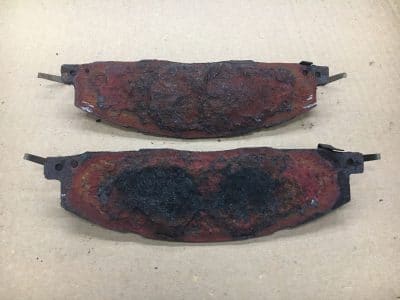Brake pads are an integral part of your car’s braking system, which means that it is crucial that they are in good working shape. If you do not replace your brake pads when they wear down beyond their minimum spec, it can lead to numerous other costly problems. To avoid that, it is a good idea to be aware of just how long brake pads are supposed to last and how often they need to be checked.
How Long Do They Last?
 The lifespan of brake pads varies depending on things like your personal driving style and road conditions. If, for example, you are constantly traversing rough roads that require frequent braking, the pads will wear faster than if you are often driving on smooth roads. What’s more, if you are the kind of driver that is heavy on the brakes, you will likely notice that you are replacing brake pads more often.
The lifespan of brake pads varies depending on things like your personal driving style and road conditions. If, for example, you are constantly traversing rough roads that require frequent braking, the pads will wear faster than if you are often driving on smooth roads. What’s more, if you are the kind of driver that is heavy on the brakes, you will likely notice that you are replacing brake pads more often.
While there is no definite lifespan for brake pads as with other parts, both mechanic websites and manufacturers agree on a longevity of between 50,000 to 90,000 kilometers. The longevity of brake pads also varies based on the type being used and the material they are made out of. Here is a breakdown of the different types of brake pads there are so you can get a better idea of their expected lifespan:
- Synthetic/ceramic – Usually made out of aramid fibers and fiberglass, these brake pads are stronger, have better stopping power, and weigh less than other types of brake pads. Because of these traits, they also tend to be among the most expensive. That cost may be worth it, however, when you compare their durability to that of other brake pad types.
- Metallic – These were typically used for racing and have become almost obsolete due to the invention of other brake pad compositions.
- Semi-metallic – These pads are a mixture of organic and metallic materials (typically copper, steel, or iron). These pads tend to have a higher level of heat resistance and are harder than other types.
- Organic – Made from non-metallic fibers, these types of brake pads are heat resistant and reduce noise. They have considerable stopping power but tend to wear quickly.
When Should They Be Checked?
There are some telltale signs that your brake pads are starting to wear. If you hear screeching or squealing sounds when you apply pressure to the brake, it is definitely time to get them checked out. That sound you are hearing actually comes from a metal shim that is in the brake pad specifically for this reason – it is meant to notify you that your pads need to be replaced.
Another sound you may hear is a metallic grinding sound. If this happens, it means that your brake pads have actually worn down to nothing and the metal backing of the pad and the rotor are making contact with each other. Metal on metal contact like this can very quickly do further damage to your brakes as a whole, so be sure to bring your car in to a mechanic as soon as possible.
 A visual inspection of the brake pads can let you know what condition they are in. You can see the brake pad by looking through your tire spokes to see the pad against the brake rotor. If there is less than a 3/16 of an inch of brake pad left, it means you should probably replace them, or at least you should get an inspection done. When pads get too thin they can overheat and are not as effective due to brake fade.
A visual inspection of the brake pads can let you know what condition they are in. You can see the brake pad by looking through your tire spokes to see the pad against the brake rotor. If there is less than a 3/16 of an inch of brake pad left, it means you should probably replace them, or at least you should get an inspection done. When pads get too thin they can overheat and are not as effective due to brake fade.
One final indication of worn brake pads is one you will likely only find in newer vehicles: an indicator light. In the event the light comes on, it is definitely time to take your vehicle in to get the brakes checked out.



